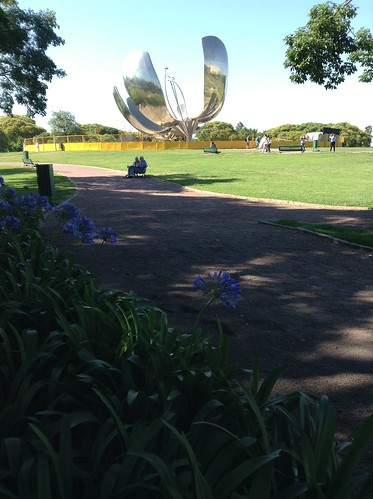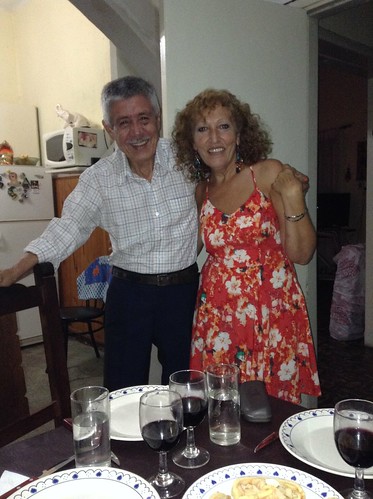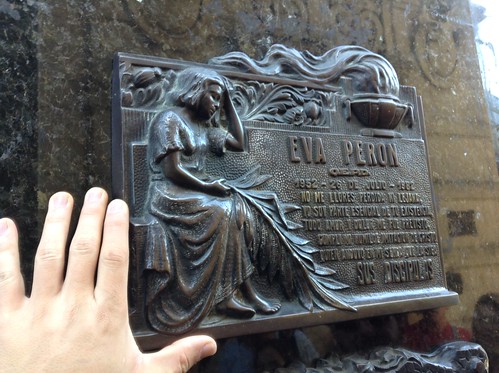
When Eva Perón died at age 32, her body was embalmed and put on display. Millions of Argentinians flocked to Buenos Aires to see the corpse, and they still come today to visit its grave in La Recoleta Cemetery. So I went, too.
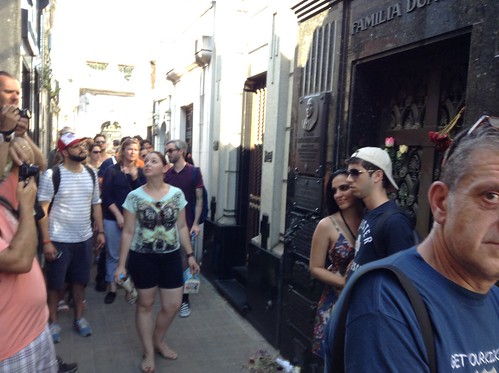 It was weird. In the otherwise empty cemetery, I was among a crowd waiting in line to snap a selfie in front of the former First Lady’s grave. It reminded me of visiting the mausoleums in Hanoi and Beijing of Ho Chi Minh and Mao Zedong, names that have also become ideological symbols. Evita’s body would likely also still be on display if it hadn’t disappeared for several decades after her death in 1952. Why it disappeared, and what happened to it, is a creepy story filled with dictators, sorcerers, necrophiliacs.
It was weird. In the otherwise empty cemetery, I was among a crowd waiting in line to snap a selfie in front of the former First Lady’s grave. It reminded me of visiting the mausoleums in Hanoi and Beijing of Ho Chi Minh and Mao Zedong, names that have also become ideological symbols. Evita’s body would likely also still be on display if it hadn’t disappeared for several decades after her death in 1952. Why it disappeared, and what happened to it, is a creepy story filled with dictators, sorcerers, necrophiliacs.
I thought the American musical Evita might offer some insights into Argentina’s obsession with the wife of former President Juan Perón, so on YouTube I watched the scene where Madonna sings “Don’t Cry for Me, Argentina.” Rather than suffer through any more of the film, I visited the Museo Evita in Buenos Aires, which taught me that Eva had gained some recognition as a B-actress, caught the eye of an military officer, and married him despite being 25 years his younger. (Kind of like Marilyn Monroe marrying JFK, instead of just having an affair.) Eva then endeared herself to the public by focusing on social programs and mingling easily with the poor. Then she died.
But why are images of Evita are still everywhere in Argentina, and none of her husband? Why did she get her own Broadway musical and Hollywood film? Why did Madonna beg for the star role (beating out Michelle Pfeiffer)? I finally got an explanation from Alma Guillermoprieto’s 1996 article in The New Yorker about the actress-turned-politician-
Evita did not live on in memory because of the way she looked but because she looked beautiful, bejeweled, and radiant while consuming herself in a flame of devotion to her husband and the poor. The dramatic change in her appearance has historical significance… from a pushy, selfish twenty-six-year-old starlet (her age when Juan Perón first came to power) to a flagellant compelled to take on the suffering of an entire nation and make it her own.
Guillermoprieto explains what happened to Evita’s corpse, and an attempt to revive its soul:
A Spanish embalmer, commissioned by Perón even before Evita’s death, transformed her corpse into a radiant effigy. (Ever conscious of her image, Evita on her deathbed requested a postmortem manicure, to change the color of her nail varnish from red to natural.) Peronists worshiped this figure until Perón was overthrown, in 1955, when right-wing military officers snatched the body away. … In 1971, Perón was living in Madrid with his new wife, Isabelita, a former cabaret dancer with an incongruous schoolmarmish air, and with her private sorcerer, José López Rega… López Rega then staged a ceremony in which Isabelita lay on top of the coffin while he tried to transmigrate the soul of the deceased Mrs. Perón into the living one.
I don’t think that made it into Madonna’s film.
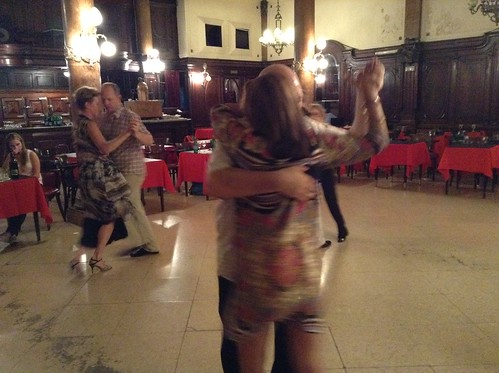 Pointing me in the direction of Evita’s grave, and generally being a patient guide around Buenos Aires, was my Argentinian friend Vanessa, who I met in December during a mountaineering expedition in the Andes. I told her I wanted to learn to tango, so she brought me to a lesson at a cool old-world cafe downtown.
Pointing me in the direction of Evita’s grave, and generally being a patient guide around Buenos Aires, was my Argentinian friend Vanessa, who I met in December during a mountaineering expedition in the Andes. I told her I wanted to learn to tango, so she brought me to a lesson at a cool old-world cafe downtown.
Vanessa works at the city’s grand Teatro Colón developing sets for the famous opera house’s plays and ballets. She was able to to sneak me inside the theater for a free guided tour, saving me about $30. To return the favor, I bought her an ice cream.

Somehow I managed to not annoy Vanessa too much, and she invited me to her family’s home in the suburbs for New Year’s Eve. The night I arrived, her mother prepared a big salad and milanesa. As we ate, her comical stepfather kept pulling from his shirt pocket a piece of paper on which he’d scribbled my name, which he theatrically read each time he addressed me. They never let me feel anything but stuffed with food and wine (and whiskey).
We toasted on New Year’s Eve — instead of exclaiming “cheers,” Argentinians say “chin-chin” — and watched the neighborhood fireworks. Afterward we went to their family friends’ house and smoked Cuban cigars and drank mojitos (which Vanessa’s stepfather kept calling “mariachis”). Before we were home, the sun was already up on 2015.
